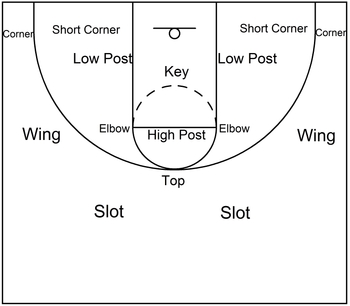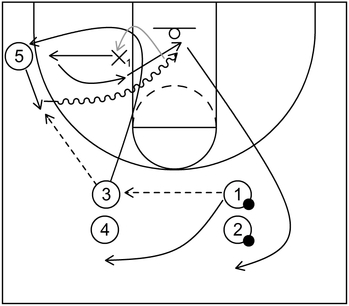What is spacing in basketball
Spacing, and more specifically, good spacing, is a foundational aspect within the game of basketball and its general notion is that players on the court, especially during offensive execution, should always strive to be at least 12 to 15 feet away from each other.
Why is spacing important in basketball
Spacing is an important concept to consider because when offensive players are able to understand and apply the fundamentals of good court spacing, this will help them to execute basketball skills such as passing, cutting, screening, dribbling, and shooting in a more effective and productive manner.
As a result of that, those same offensive players would more than likely be able to generate a variety of scoring opportunities near the basket or from the perimeter areas of the court.
Moreover, when players on offense emphasize and implement good floor spacing, this makes it more challenging for the defensive team to limit or prevent the aforementioned offensive skills.
What are the areas of the court which indicate good spacing

The areas of the court which generally indicate good spacing are the top, the slots, the wings, the corners, the high posts, and the low posts.
The top, broadly speaking, is the half court area that is above the basket and beyond the three-point arc. However, in a more specific sense, the top is the area in between the slots which begins behind the three-point arc in the middle of the court and ends at the center (or middle) of the half court line.
The slots are the areas above the wings, adjacent to the top, and beyond the three-point arc. The wings are essentially the areas behind the three-point arc near the sideline but further away from the baseline.
The corners, are basically the areas behind the three-point arc near the sideline as well as the baseline.
The high post is the half-circle area starting from one corner of the free throw line to the other corner plus the area between the free throw line and the top. In addition to that, the high post corners are also commonly known as the elbows.
The low post is an area just outside of the lane lines slightly above the basket. On an actual basketball court, it is typically shown by way of a rectangular-shaped block, and is therefore, also called a low post block.
Therefore, an offensive team could apply good spacing on the floor by having one (and only one) player fill any of the previously mentioned areas on the court.
Also, if one player fills the left side wing, then it is not an issue if another player fills the right side wing. Even though both areas are wings on the court, they are different wings and those same areas are 12 feet or more from each other.
This same rule applies to the slots, the corners, the high posts, and the low posts as well.
What is bad spacing and why is it detrimental to the offense
Bad spacing occurs when more than one player attempts to occupy or fill the same area of the court at the same exact time or two or more players are simply too close to each other when filling specific areas.
This is detrimental, particularly to an offensive team because it makes it easier for the defensive team to mitigate or completely stop offensive production, and more specifically, offensive scoring opportunities.
For example, if two offensive players are standing adjacent to each other while attempting to fill the same area of the court, then one defender could basically cover both of them with minimal effort.
In addition to that, if one of those offensive players happens to have possession of the ball, then they could become susceptible to a very quick and possibly aggressive double team by the two defenders that would be alongside each other.
Furthermore, if that same player with the ball attempts to pass it to the other teammate standing next to them, then this is essentially a futile action.
Moreover, if the player with the ball was to execute a dribble move as a method of driving to the basket or creating separation for a potential jump shot (such as with a step back basketball move), then this could become unnecessarily difficult.
Basically, when the bad spacing occurs, the player with the ball would have to not only beat their own defender (via dribble drive penetration or jump shot separation), they would also have to try to evade another teammate’s defender (that would be standing very close to them) or any other additional nearby defenders.
As another example, if one player fills the right side low post area, then another player should not fill the right side short corner (at least most of the time) because these two areas are generally less than 12 feet apart and the two players are therefore, too close to each other.
Similarly, if one player fills the top behind the three-point line, especially in between the slots, then one or two other players should not fill the slots. Once more, those players would be generally too close to each other.
So, in simple terms, the bad spacing renders offensive actions ineffective, at best or totally useless, at worst.
Affiliate Disclosure: I may earn a commission on qualifying purchases made through the links below.
What is an example of a basketball spacing drill

This is an example of a basketball spacing drill derived from Spacing & Relocation by Kelvin Sampson.
The drill is set up with two lines of offensive players near the slots as well as another offensive player in the left side corner. Additionally, there is one defender that starts near the left side low post area.
Also, the numbers indicating offensive players 1 through 5 as well as the defender (X1) are not representative of the standard basketball positions. Instead, those numbers are simply utilized for demonstration purposes.
In other words, player 1 on offense and X1 on defense do not necessarily have to be point guards. Furthermore, player 5 in the left corner does not necessarily have to be a traditional center and so forth.
The main purpose of this drill is to help the players, particularly on offense, think about and emphasize good spacing concepts as they pass the ball to other teammates, execute the corner cut, or dribble to the basket.
Coach Sampson also stated that if a corner player does not have an adequate amount of athleticism, then this drill teaches that same player a viable action which could be used to outwit the defender by beating them off the catch as opposed to beating them off the dribble.
Furthermore, in terms of the defense, the drill can aid defensive players in practicing proper closeouts as well as defensive sliding without fouling.
To begin the drill, 3 receives the ball from 1 and then 3 executes the pass to 5. However, on the air time of that pass, X1 counters with a closeout defensive tactic to prevent an uncontested jump shot or easy dribble penetration by 5.
However, as that occurs, 5 counters the closeout by cutting toward 3 to meet the ball in the air when 3 executes the pass. This essentially gives 5 the necessary space to beat X1 off the catch as opposed to something such as a dribble isolation.
Also, as 3 executes the pass, 3 quickly sprints to the basket and then to the left side corner. As that occurs, 5 dribbles toward the basket and could try to score near the rim via a layup while X1 executes a defensive slide to slow down the dribble penetration and prevent an uncontested layup.
Once 5 attempts to score at the basket, X1 will grab the rebound or get the ball out of the net and then, the drill is complete.
Following that, several of the players will shift to new areas.
1 should move to the back of the line near the left slot; it should be noted that 1 could also move to this line earlier in the drill as well, particularly after executing the initial pass.
X1 will keep hold of the basketball after the shot attempt by 5 and then become an offensive player by cutting to the back of the line near the right slot area. 5 will become the new defender and cut to the left side low post block, represented by the gray arrow.
3 already cut to the corner and would be the new corner player that tries to beat the defender off the catch. From that point, the drill could start once again.
What are examples of offensive strategies that emphasize good spacing
The 1-4 high offense is a basketball offensive strategy that primarily utilizes the high post as well as the wing areas to create scoring opportunities near the basket or from the perimeter, typically with a variety of basketball cuts and/or basketball screens.
The 2 out 3 in motion offense is a basketball offensive strategy that emphasizes ball movement, post split action, and continuity patterns to create scoring opportunities near the basket or from the perimeter.
The 3 out 2 in motion offense is a basketball offensive strategy that seeks to create multiple scoring opportunities through the use of set plays as well as offensive actions such as basketball screens, basketball cuts, continuity patterns and pick and roll options among others.
The 4 out 1 in motion offense is a basketball offensive strategy that creates scoring opportunities via a variety of sequences such as basketball cuts, basketball screens, and dribble drive action.
The 5 out motion offense is a basketball offensive strategy that focuses on spacing the floor while utilizing the fundamental skills of passing, cutting, and screening as well as continuity patterns to create scoring opportunities, typically near the basket or from the perimeter.
The box offense is a basketball offensive strategy that utilizes a variety of off-ball and on-ball screens to create scoring opportunities, particularly for the team’s best scorers.
The circle offense is a basketball offensive strategy that utilizes cuts and continuity patterns to create scoring opportunities near the basket.
The flex offense is a basketball offensive strategy that creates scoring opportunities near the basket or from the perimeter by way of two types of basketball screens known as the flex screen and the down screen.
The Horns offense is a basketball offensive strategy which emphasizes spacing to create scoring opportunities near the basket or from the perimeter by way of various actions such as basketball screens and dribble handoffs.
The Princeton offense is a basketball offensive strategy which utilizes the fundamental skills of cutting, dribbling, passing, screening, and shooting as well as spacing and ball movement to create scoring opportunities near the basket or from the perimeter.
The triangle offense is a basketball offensive strategy in which players form a sideline triangle on one side of the court and a two-man game on the opposite side to create scoring opportunities via the use of various offensive actions.
The UCLA offense is a basketball offensive strategy that focuses on the fundamentals of passing, screening, and cutting to create various scoring opportunities, primarily near the basket but also from the perimeter.